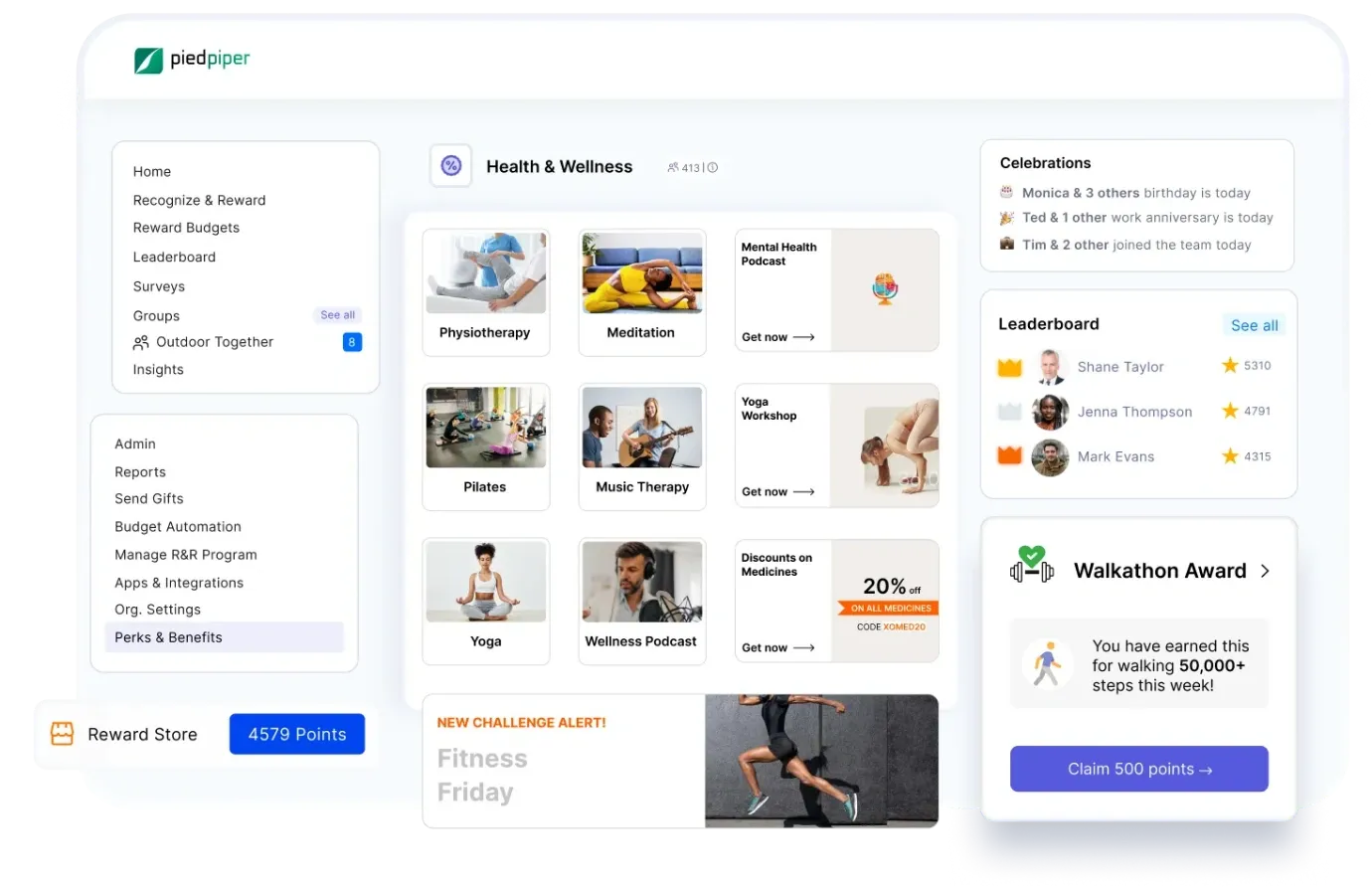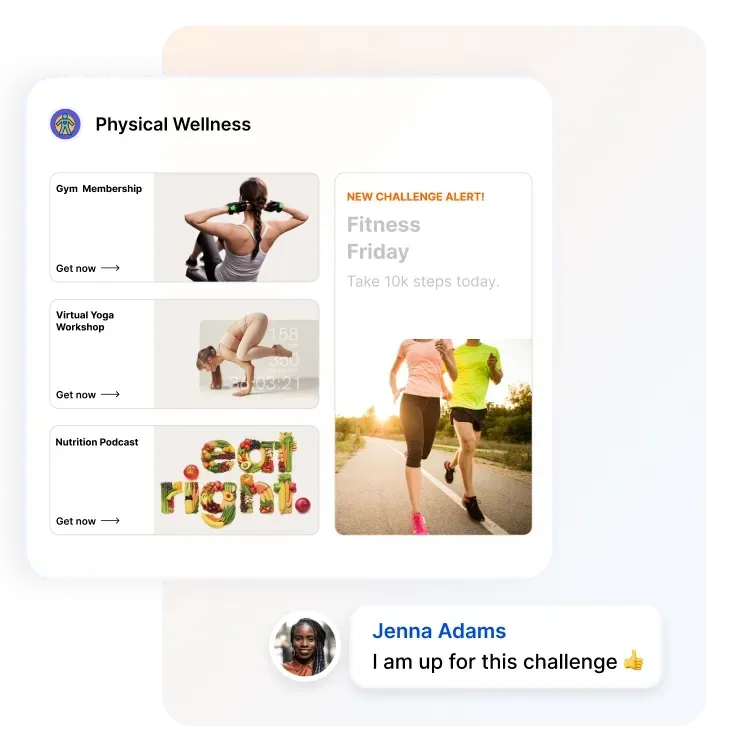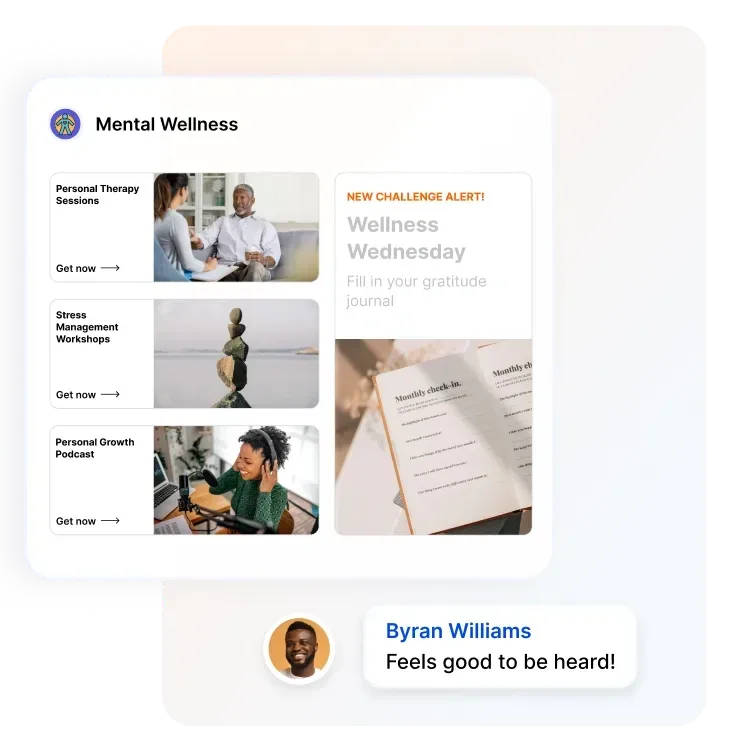The Ultimate Guide to Building an Effective Employee Wellbeing Program
An employee wellbeing program enhances productivity, engagement, and retention. Learn how to create a workplace culture that prioritizes employee well-being and success.
En esta página
- Understanding employee wellbeing programs
- Los beneficios de los programas de bienestar de los empleados
- Factores que afectan al bienestar de los empleados
- ¿Cómo no establecer un programa de bienestar en el lugar de trabajo?
- Then how do you create effective employee wellbeing programs?
- Top 8 employee wellbeing programs to implement in 2025
- How Empuls enhances employee wellbeing programs
- Conclusión
Todas las empresas quieren que sus empleados sean felices y estén sanos. Por eso muchas pequeñas empresas y grandes corporaciones están empezando a pensar en cómo pueden contribuir a la salud y el bienestar de los empleados.
Since people spend so much of their lives at work, this is a very vital concern for employers.
Y centrarse en la salud mental y el bienestar de los empleados en el trabajo no es sólo algo agradable de proporcionar, sino que es realmente beneficioso para muchas áreas de su empresa.
So if you want to keep your best employees and help them do great work, you need to focus on improving employee well-being. But let’s be honest - there are plenty of poorly designed health and wellbeing programs for employees out there.
Entonces, ¿cómo puede estar seguro de que está creando uno que sus empleados realmente le agradecerán? Después de todo, los programas de bienestar en el lugar de trabajo sólo funcionan bien cuando los empleados participan a menudo y con entusiasmo.
No hay que temer: estamos aquí para guiarle en todo lo que necesita saber para crear un programa de bienestar que sus empleados adoren.
Comencemos.
Understanding employee wellbeing programs
Employee wellbeing programs focus on improving the physical health of employees at your company.
Su aspecto es un poco diferente en cada organización, pero muchos de ellos incluyen características como programas para dejar de fumar, descuentos en la suscripción al gimnasio, aperitivos saludables en la oficina, competiciones de pasos y mucho más.
Many wellbeing programs are also now beginning to focus on mental health as well as physical. By implementing programs like EAP (Employee Assistance Programs), stress reduction programs, meditation programs, and more.
Se trata de mejorar la salud de los empleados facilitando y abaratando un estilo de vida saludable.
Los beneficios de los programas de bienestar de los empleados
¿Por qué invierten los empresarios en estos programas? Pueden ser bastante costosos, dependiendo de los programas que elija su organización.
Pero a pesar del coste y del esfuerzo necesario para ponerlas en práctica, suelen ser muy eficaces y tienen un gran retorno de la inversión.
Esto se debe a que los empleados felices y sanos son mucho más productivos y comprometidos que los empleados cansados, estresados, preocupados o enfermos.
En un nivel básico, mantener a los empleados sanos significa que no faltan al trabajo tan a menudo, y eso es obviamente bueno para el éxito de su empresa. Además, el rápido aumento de los costes sanitarios en lugares como EE.UU. significa que los empleados que enferman pueden suponer una enorme pérdida de recursos para la empresa.
Pero ser productivo y estar comprometido significa que los empleados también necesitan tener menos niveles de preocupación y estrés en sus vidas, y muchos programas de bienestar de los empleados más avanzados también se ocupan de eso.
The World Health Organization says that mental illness is now the leading cause of disability and illness. High levels of chronic stress caused by unhealthy workplace cultures have a real impact on employee engagement and productivity.
No one does their best work when surrounded by stressful conditions. But as sad as that sounds, well-designed employee health and wellness programs can help alleviate many of those problems.
Sus empleados no sólo estarán más sanos y serán más productivos, sino que también se sentirán apoyados y más contentos de trabajar en una organización que les cuida tanto. Esto se traduce en una menor rotación de personal y una mayor satisfacción laboral.
Factores que afectan al bienestar de los empleados
Hay tres factores esenciales que aumentan la salud y el bienestar de los empleados en el trabajo, y hoy los trataremos en profundidad, para que sepa exactamente lo que tiene que hacer para tener empleados más felices, más sanos y más productivos.
1. Control del trabajo
One of the biggest factors in employee well-being (and employee engagement) is their discretion over what they do and how they do it. That’s the basis of job control.
Limited job control is linked strongly with poorer physical health, including higher death rates, heart disease, and diabetes.
El control del trabajo también es un factor importante para la salud mental. Numerosos estudios han descubierto que las personas con mayores niveles de control en el trabajo tienen menos ansiedad y depresión.
Estos hallazgos significan que, aunque los trabajadores de mayor nivel tienden a realizar tareas más estresantes, tienen más responsabilidades y suelen trabajar muchas horas, tienen menos efectos negativos sobre la salud de sus carreras porque tienen mayores niveles de control del trabajo.
It might seem fairly challenging to increase job control for lower-level workers who are mostly responsible for repetitive, boring tasks where they lack control. But it just takes some imagination to look at a new way to increase job control.
For example, reducing the amount of micromanaging that leaders and managers do is a great first step. While managers certainly need to manage their people, getting too into the details and controlling employees is unhelpful for everyone.
If you’re hiring the right people, you really should be letting them do the jobs they were hired to do with the skills they have and not watching their every move. And even workers infamously tightly controlled phone lines can be given additional autonomy with some creative thinking.
Collective Health empowered its “patient advocates” who answer phones to solve complex patient problems to solve problems on the floor as they come up, instead of giving them a strict script.
This has increased employee retention, satisfaction, and motivation. And it’s proved more efficient at solving customer problems as well - everybody benefits.
2. Motivating employees
Job control doesn’t just affect physical and mental health - it also has a strong impact on how motivated and engaged employees are in their jobs. When employees work in an environment where they don’t have much control over their work or how they get it done, it creates stress and uncertainty.
Es posible que se les obligue a seguir procedimientos ineficaces o anticuados y que luego se les castigue por los malos resultados o que se les fijen objetivos imposibles de alcanzar en sus funciones.
Cuando esto ocurre, es difícil que un empleado se comprometa a ir más allá. Cuando uno no se siente dueño de sus tareas, disminuye la competencia y los logros.
That’s not a workplace that encourages you to try your best because it probably won’t be recognized or rewarded if you do. Low job control makes workplaces feel chaotic and unpredictable - you don’t have control over your role or tasks, so it’s hard to predict your actions' outcomes. That is a pretty significant demotivator for most employees.
3. Social support
Tener amigos y una red social sólida es muy beneficioso para la salud y ayuda a disminuir el estrés, incluido el estrés laboral. Pero en muchas empresas, la vida en el lugar de trabajo en realidad disminuye los sentimientos de apoyo y conexión social.
¿Suena sorprendente? No lo es si se tiene en cuenta el entorno de muchas empresas punteras. Muchos lugares de trabajo tienen medidas de rendimiento que enfrentan a los trabajadores entre sí, como los sistemas de clasificación o promoción de curvas forzadas. En cada ciclo de revisión sólo puede participar un número determinado de empleados.
Otras empresas tratan a los empleados como si tuvieran una relación puramente transaccional, en la que el trabajo se intercambia sólo por dinero.
4. The right employee wellbeing framework
Cuando la mayoría de las empresas piensan en un programa de bienestar para los empleados, se centran en conseguir que éstos adopten por sí mismos comportamientos más saludables. Esto podría significar dejar de fumar, beber menos, hacer más ejercicio o comer más sano.
Las empresas suelen poner en marcha estos programas no para centrarse en las necesidades de los empleados, sino para reducir sus propios costes sanitarios. Ese es el marco equivocado para el bienestar de los empleados.
The drivers of unhappy and unhealthy employees are more often factors in the control of employers - unfair workplace practices, unmanageable workloads, lack of role clarity, poor communication, and not enough time to get work done.
Aunque hacer más ejercicio y meditar puede ciertamente reducir los síntomas del estrés, si su programa de bienestar de los empleados no aborda las causas fundamentales de ese estrés, no va a resolver el problema con un descuento en el gimnasio.
Dar a las personas una carga de trabajo razonable y un sentido de la equidad en el trabajo contribuirá en gran medida a reducir los costes sanitarios relacionados con el estrés.
Los empleados también quieren algo más que un descuento en el gimnasio para cuidar su salud, especialmente si están demasiado cansados o quemados por el trabajo como para ir al gimnasio todos los días.
5. Improving employee wellbeing
El bienestar de los empleados es algo más que un detalle. Es vital para la salud de los seres humanos que trabajan para usted, y también es un motor empresarial positivo.
Los empleados que no tienen niveles elevados de estrés laboral ni de agotamiento tienen control sobre sus tareas, y las conexiones sociales fuertes en el trabajo son más productivas y comprometidas.
Wondering how further to promote that link between employee wellbeing and performance? You can simply ask your employees how they’re regularly feeling to learn how to handle stress at your workplace and what they really want from wellbeing programs. Let’s discuss about employee wellbeing programs.
¿Cómo no establecer un programa de bienestar en el lugar de trabajo?
Mientras que todos estos beneficios son posibles si eliges los programas de bienestar adecuados, se van por la ventana si seleccionas el equivocado. ¿Qué significa esto?
¿No es una buena opción todo lo que tiene por objeto ayudar a sus empleados a estar sanos? ¿No estarán agradecidos?
Bueno, no siempre. Seguramente has hecho bien tu trabajo y has contratado a gente muy inteligente: ellos verán los esfuerzos que benefician a tu empresa más que a ellos.
Si sus programas de bienestar están diseñados principalmente para reducir las primas de los seguros castigando a los empleados por comportamientos poco saludables, éstos no van a estar contentos y no van a participar tan activamente como a usted le gustaría.
As Deloitte has found, there’s actually often a huge gap between what employers think their people need, and what employees actually want. That’s why doing your research properly is vital before you commit to an expensive and unpopular wellbeing program.
And SHRM notes that focusing exclusively on physical wellness is pretty ineffective for most organizations, so it’s better to think holistically about wellbeing.
Then how do you create effective employee wellbeing programs?
Creating a wellbeing program that truly resonates with employees requires more than good intentions—it demands research, personalization, and employee input. Here’s how to do it right:
1. Start with listening: ask, don’t assume
Instead of making assumptions, directly involve employees in the design process:
- Use surveys to understand what employees value most in wellbeing support.
- Ask about stressors, preferred perks, and areas needing improvement.
Tools like Empuls offer lifecycle, eNPS, and pulse surveys with AI-driven insights to uncover employee needs and track sentiment over time.
2. Identify root causes, not just symptoms
Don’t just encourage healthier habits—address systemic workplace stressors:
- Evaluate workloads, fairness, communication gaps, and leadership quality.
- Prioritize job control, autonomy, and social support, which research shows are core to wellbeing.
- Recognize that burnout isn’t solved with a gym pass—it requires structural fixes.
3. Design holistic, flexible programs
Include a variety of initiatives that support:
- Physical wellness: fitness benefits, step challenges, health screenings.
- Mental wellness: therapy sessions, meditation apps, stress management workshops.
- Financial wellness: salary advance programs, tax-saving perks, early wage access.
- Lifestyle needs remote work support, childcare, and learning allowances.
Empuls offers all of the above via customizable Lifestyle Spending Accounts (LSA) and fringe benefits across 50+ countries.
4. Ensure inclusivity & personalization
Avoid one-size-fits-all approaches. Offer choice and flexibility in benefits—e.g., wellness options, rewards, and discounts that reflect different life stages and preferences.
Empuls enables modular configuration of wellbeing programs based on roles, locations, and demographics.
5. Communicate transparently
Even the best program fails without awareness. Ensure clear communication on what's offered and how to access it.
Use internal communication platforms like Empuls Social Intranet to drive awareness, updates, and engagement.
6. Automate for consistency & scale
Automate key touchpoints like:
- Birthday wishes, service anniversaries, wellness nudges, and rewards
- Personalized milestone recognitions to show continuous care
Empuls supports automated workflows and AI nudges to streamline delivery and ensure no moment is missed.
7. Measure impact & iterate
Track participation, sentiment, and ROI:
- Use analytics dashboards to identify what’s working and what’s not.
- Iterate based on continuous feedback to improve adoption and effectiveness.
Empuls provides real-time reporting and people analytics to measure program performance and engagement levels.
By co-creating programs with employees, aligning with their actual needs, and leveraging platforms like Empuls for automation, insights, and personalization, your wellbeing initiatives will be not only effective—but genuinely appreciated.
Top 8 employee wellbeing programs to implement in 2025
Ahora que conoce las ventajas -y los inconvenientes- de los programas de bienestar para empleados, ¿cuáles debería considerar?
He aquí algunos de los mejores programas de bienestar que sus empleados le agradecerán. No son solo nuestras ideas, sino que están respaldadas por lo que los empleados de todo el mundo quieren realmente (pero no olvides consultar también a tus propios empleados).
1. Flexible work schedules
Puede que esto no le parezca un beneficio para el bienestar, pero lo cierto es que los empleados son más felices y saludables cuando tienen más control sobre dónde y cuándo trabajan.
With so many options for designing flexible work schedules that work for your business, you can provide flexibility and autonomy for your employees so they better balance their work and life together. In fact, Harvard Business Review says that employees thrive when they’re offered these options.
2. Healthy office snacks
Muchos empresarios piensan que están haciendo un gran servicio a los empleados al proporcionarles galletas y dulces para que piquen en el lugar de trabajo. Aunque esto puede ser satisfactorio a corto plazo, los empleados quieren que se les ofrezcan más opciones saludables.
Google provides low-cost healthy snacking options in all of its offices, which employees love. And healthy snacks prevent the mid-afternoon sugar crash from sapping productivity out of your employees too.
3. Wellness counseling
Estar sano y saludable puede ser un reto en nuestro mundo acelerado y lleno de comida rápida. A los empleados que quieren estar sanos les puede resultar difícil saber exactamente qué pasos dar.
Por eso el asesoramiento sobre bienestar se ha hecho tan popular como programa de bienestar en el lugar de trabajo: los empleados pueden recibir orientación personalizada y ayuda para llevar una vida más saludable en sus propios términos.
4. Mental health counseling
Conseguir ayuda cuando la salud mental se resiente suele ser difícil en muchos lugares. Pero una mala salud mental puede acarrear graves problemas tanto en el trabajo como en la vida personal.
Ayudar a sus empleados a acceder a un asesoramiento sobre salud mental es algo muy popular entre los empleados y también algo compasivo, por lo que es una gran idea pensar en cómo podría ofrecer esto.
5. Parental support
Being a working parent is hard for both mothers and fathers. It can be a big challenge to balance work and childcare every day. In fact, US employers lose about $13 billion a year due to lost productivity and earnings due to inadequate childcare.
Ofrecer apoyo, como un generoso permiso parental retribuido, complementos para el cuidado de los hijos, opciones de guardería de apoyo, etc., puede suponer una gran diferencia en la vida de los padres que trabajan para usted, y éstos tienden a ser empleados muy leales en respuesta.
6. Destressing programs
El estrés en el lugar de trabajo es un problema importante y creciente en muchas empresas, incluso en la mayoría. Incluso si se han hecho esfuerzos significativos para crear una cultura de trabajo saludable y de apoyo, el estrés puede aparecer a veces durante las temporadas de trabajo o en torno a grandes proyectos.
Managing that stress can be hard alone, so implementing programs that help employees learn how to deal with stress can be a big benefit. This could be yoga classes, tai chi, meditation lessons, or other relaxation techniques - Wegman’s offers customized yoga plans for employees, for example.
7. Community involvement
Es cierto: los empleados valoran mucho poder contribuir a sus comunidades. Darles tiempo libre remunerado para que se ofrezcan como voluntarios u organizar jornadas de voluntariado con tus equipos contribuye en gran medida a que tus empleados se sientan felices y apoyados.
Plus, it benefits the larger community and the image of your business as well. Liberty Mutual Insurance offers annual days of service called Serve with Liberty, which half of their employees across the globe participate in.
How Empuls enhances employee wellbeing programs

Empuls helps organizations design effective employee wellness programs by addressing both physical and mental well-being. With a data-driven approach, it enables HR teams to build workplace wellbeing programs that employees appreciate and actively engage with.
1. Physical wellness: Supporting a healthier workforce

Empuls promotes employee wellbeing by offering flexible options for physical health, allowing employees to choose what suits them best. From fitness challenges with rewards to gym memberships, virtual yoga classes, and nutrition consultations, employees can access a variety of wellness resources that align with their personal health goals. With Empuls, you get:
- Fitness challenges, gym memberships, and yoga classes
- Mental wellness tools: stress management workshops, therapy sessions, meditation apps
- Flexible fringe benefits: Lifestyle Spending Accounts (LSA) for health, travel, meals, learning
2. Mental wellness: Reducing stress and improving focus

To help employees manage stress, Empuls integrates mental wellness solutions into employee wellbeing programs. Companies can offer personal therapy sessions, stress management workshops, and meditation app subscriptions to help employees improve sleep, breathing, and overall mental resilience.
3. Comprehensive benefits for both employees and employers
For HR teams: Fully customizable to fit company-wide workplace wellbeing programs. Scalable across locations and available on all devices. A robust reporting suite with 24/7 access to data-backed insights and actionable recommendations.
For employees: Holistic support across personal, financial, physical, and mental wellness. Exclusive discounts and extended coverage beyond standard insurance. 24/7 customer support, including multilingual assistance, chat support, and a help center.
By leveraging Empuls’ employee wellness solutions, businesses can create a culture that prioritizes employee wellbeing, enhances engagement, and reduces workplace stress, leading to a happier and more productive workforce. Schedule a call now!
Conclusión
Creating an effective employee wellbeing program isn’t just a checkbox exercise—it’s a strategic investment in your company’s most valuable asset: your people. When employees feel physically healthy, mentally supported, financially secure, and socially connected, they bring their best selves to work. The result? A thriving workplace culture, lower attrition, and higher performance across the board.
But getting wellbeing right requires more than good intentions—it demands the right tools, data, and flexibility to meet the diverse needs of your workforce.
That’s where Empuls makes a real difference.
Empuls helps you design, manage, and scale impactful wellbeing initiatives with an AI-powered, data-backed platform that’s loved by both HR leaders and employees alike. From flexible benefits and mental health resources to global perks and continuous feedback loops, Empuls empowers you to build a culture where everyone can do their best work—and feel great while doing it.
Ready to create a workplace your employees won't want to leave? Start your journey with Empuls today. Schedule a call now!











